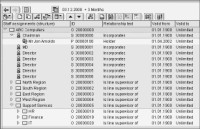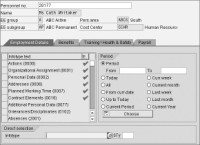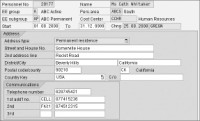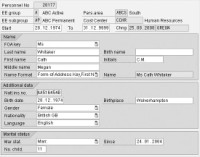 Discover SAP ERP HCM
Discover SAP ERP HCM
Chapter 2: SAP ERP HCM Employee Administration
Companies need to know how to keep up with constantly-changing employee information and records. But how can companies meet the challenges of storing and accessing sensitive employee data on a regional and global scale? Where can organizations store employee data as it changes over time?
In this chapter, learn how to use SAP ERP HCM Employee Administration, and how it can be integrated with other components of SAP ERP HCM.
SAP ERP HCM Employee Administration, the key component in SAP ERP HCM, is built around the Personnel Administration (PA) component. In this section, learn about the types of data that can be stored in Employee Administration, such as HCM Infotypes and pay structures, and learn how to set up the three company structures needed to map your company into Employee Administration.
TABLE OF CONTENTS:
- Understanding and using SAP ERP HCM Employee Administration
- SAP ERP HCM wage types, pay structures and master data maintenance
- Case studies on maximizing SAP Human Capital Management (HCM) benefits
Chapter 2: SAP ERP HCM Employee Administration
SAP ERP HCM Employee Administration
In today's rapidly globalizing marketplace, companies around the world grow, expand, acquire, and merge at a rapid pace. As a result, companies are faced with maintaining unprecedented volumes of employee data. The challenges and complications of storing and accessing sensitive employee data globally, while also making it accessible and tailoring it to local and regional demands, presents major issues for companies.
The SAP ERP HCM Employee Administration functionality is designed to face these demands and has three key purposes. First, it acts as a centralized database for all of your employee master data, enabling system users, management, and employees to access up-to-date, consistent and relevant information to support decision making. Second, it's the part of SAP ERP HCM where you define your company structure, and create a framework that meets your processing and reporting requirements while working well for your employees. Third, it's designed to enable your company to automate and streamline most of your day-to-day HR processes, saving you time and money and allowing your HR department to focus on strategic rather than administrative activities.
This excerpt from Discover SAP ERP HCM by Greg Newman is reprinted here with permission from SAP Press; Copyright 2008.
Download a pdf of this chapter.
Because Employee Administration is the core function of SAP ERP HCM, it's the bedrock that all of your other SAP ERP HCM components are built upon. It is critical that you understand the Employee Administration functions and keep in mind their possible impact on other SAP ERP HCM components when designing and implementing the system.
This chapter will give you an understanding of how Employee Administration is used, how it's structured, and how it integrates with other SAP ERP HCM components, along with some of the key concepts behind Employee Administration in general.
How SAP Employee Administration Fits into an Enterprise
Because it is the central database for storing employee data, the Employee Administration function is the key component in SAP ERP HCM. When companies use SAP ERP HCM, this function is the most frequently accessed part of the solution.
All other employee-related HCM processes, such as recruiting, performance management, and payroll, reference and make decisions based on the data stored in this function, so employee administration sits at the heart of your company.
The Employee Administration function is built around the Personnel Administration (PA) component, which is where all of your employees' data is stored. A large amount of the information input into other SAP ERP HCM components ends up stored in PA and can be accessed from Employee Administration. This means that in addition to your core employee data, you can view data from many of the other SAP ERP HCM components from inside the Personnel Administration component.
To understand SAP ERP HCM Employee Administration, we need to answer the following questions:
- What information can you store in Employee Administration?
- How does SAP ERP HCM refer to this information?
- How is employee data stored?
- What can you do with it?
What Information Can You Store in Employee Administration?
As befitting an SAP ERP HCM system that is used by over 10,000 companies around the world, you can store almost any data in Employee Administration. The data is stored in various forms, beginning with employee data, which is stored in records called infotypes.
Each employee record has multiple infotypes: one that contains details of his current organizational assignment, one that details his basic pay, one for bank details, and one for his address.
Employee Administration's main purpose is to store infotypes that record the history of a person's employment with your company. Every employee has many infotypes stored for his employee number, so in Employee Administration, among other things, you can quickly view all of the positions that an employee has held in your company and all of the changes to salary over his employment history. Having your employee data stored in infotypes gives you a logical, controlled, and secure structure that ensures your administrators can access and maintain the data in a way that makes Employee Administration efficient and streamlined.
SAP ERP HCM delivers over 650 standard infotypes catering to all of your employee data storage requirements, ranging from recording your employees' civil awards and decorations (Infotype 0861) to the finer details of their garnishment orders (Infotype 0195).
We'll talk more about infotypes and the other objects used to store employee and organizational data in the following sections, but you'll also need to configure your company structure in Employee Administration so that you can map out where your employees physically and legally work. So first, let's look at the structures that SAP ERP HCM uses to define the legal and physical structure of your company.
How Is Your Company Defined in Employee Administration?
Before you can organize your employee data in SAP ERP HCM, you need to set up your company structure, which is largely determined by your legal and reporting requirements. Employee Administration uses three separate but related structures to map your company into Employee Administration:
Enterprise Structure
The enterprise structure is the method used for defining how your organization is set up in SAP ERP HCM. Aligning your company correctly to this structure is one of the most important steps of an SAP implementation, because the enterprise structure defined here can have important ramifications on later decisions, not just in Employee Administration but in many other SAP ERP HCM components as well.
The SAP objects that combine to make up the enterprise structure are shown in Table 2.1.
| Object | Description | Example |
| Client | SAP system clients have an independent status both in legal and organizational terms. The clients in a SAP system can be distinguished by a three-character alphanumeric code. Generally, you will have a client for production, one for testing, and one for development. | 001 -- Connells International Curtain Company Production System |
| Company code | These are set up as part of the Finance component, but they are subsequently used in SAP ERP HCM. Legal entities, currencies, and countries are set at a company code level. | CO01 -- England Curtain Company CO02 -- USA Curtain Company |
| Personnel area | These are sub-units of a company that are specific to Personnel Administration; they usually define such things as geographical locations and function areas. A personnel area can only belong to one company code. | P001 -- England Operations P002 -- Scotland Operations P0003 -- West Coast Operations P004 -- East Coast Operations |
| Personnel subarea | A further subset of personnel area, these are used to define grouping and defaults for payroll processing and time management decision making. | S002 -- Head Office S003 -- Deliveries |
Personnel Structure
As opposed to the enterprise structure, which defines the organization from a legal and physical point of view, the personnel structure defines the organization from the employees' point of view. Because the personnel structure is used to separate and group all of your different types of employees, it's frequently used as a decision point in payroll processing, time management, and shift planning, so it's vital that these groupings cater to all of the separate categories of employees within your company.
The personnel structure in SAP ERP HCM is defined by the objects in Table 2.2.
| Object | Description | Example |
| Employee group | Used to classify different types of employees at a high level, defining the different types of workforces and terms and conditions of employment | 01 -- Directors 02 -- Management 03 -- Salaried Staff 04 -- Wage Staff 05 -- Temporary Workers 06 -- Pensioners |
| Employee subgroup | A subset of an employee group, the lowest level of granularity when it comes to defining your employees. | 04-01 – Apprentices 04-02 -- Craftsmen 04-03 -- Laborers |
| Payroll area | A grouping of employees with the same payroll rules, for example, pay period, pay date, calculation method | P1 -- Monthly Payroll P2 -- Weekly Payroll P3 -- Bi Weekly Payroll |
Organizational Structure
The third of the key structures used in Employee Administration is the organizational structure. This will be covered in more detail in Chapter 10, but in brief, the organizational structure represents the functional structure of employees in the organization. It defines the organizational hierarchy, the reporting and authority lines, and organizational groupings. The organizational structure is defined by the personnel development (PD) objects as shown in Table 2.3.
| Object | Description | Example |
| Organizational unit | A logical, functional grouping of the organization. When arranged in a hierarchical order within an organization, they form an organizational structure. | Finance Department, Payroll Office, Mechanics Workshop, Special Response Team |
| Position | A position in an organization is an individual assignment held by a specific employee | Head Mechanic Diesel Mechanic Petrol Mechanic Small Engine Mechanic Apprentice Mechanic |
| Job | A general set of work duties, tasks and responsibilities; the same job may define many positions in an organization | Manager Mechanic Apprentice Mechanic |
| Organizational key | A customer-specific subset of the organization used for control of authorizations | CO02S001 USA Head Office |
Figure 2.1 shows an example organizational structure with organizational units, positions, and one employee.
How Is Employee Data Stored?
Now that you have a general understanding of the SAP ERP HCM structure behind your company and how it is stored in Employee Administration, let's look at the different types of information we can store in Employee Administration and the structures that SAP ERP HCM uses to control this information. The main elements relating to storing employee data we need to understand are:
- Infotypes
- Wage types
- Pay structures
- Work schedules
These are ERP-specific terms for the different structures used to store employee data.
Infotypes
Recording, accessing, reporting, and maintaining your employee data is the primary aim of the SAP ERP HCM system. To do this, a structure called an infotype is used to store pieces of employee data together in logical groups. These infotypes provide a storage structure, facilitate data entry and maintenance, and let you store data for specific timeframes, or validity periods. As mentioned earlier, infotypes are the key concept in Employee Administration. Some of the most commonly used infotypes include:
- 0000 -- Actions
- 0001 -- Organization Assignment
- 0002 -- Personal Details
- 0007 -- Work Schedule
- 0008 -- Basic Pay
- 0014 -- Recurring Payments and Deductions
- 0015 -- Additional Payments and Deductions
Infotype records are valid for a specific period of time, so, for example, as an employees' salary is changed during his employment, the employee will build up a chain of date-based infotype records showing a history of his salary changes.
Each infotype is defined by a four-digit key, and where subsets of the infotype data are required, the infotypes have subtypes. These subtypes are also defined by a four-digit key.
Infotypes fall into the following categories:
- Personnel Administration infotypes
- Personnel Development infotypes
Let's explore these in a little more depth.
Personnel Administration Infotypes
Personnel Administration infotypes can be maintained via the Maintain Master Data transaction. Figure 2.2 shows a transaction with an example employee and some of the infotypes maintained with it.
Personnel Administration infotypes are used to record employee-based information. Within Personnel Administration there are two different types of infotypes:
- International infotypes
These are used by many countries, and it's worth noting that within this set, SAP allows country-specifi c views of international infotypes to provide more flexibility. - Country-specific infotypes
Where required, SAP has also provided country-specific infotypes to meet country-specific requirements.
International Infotypes
These are the most widely used infotypes and are used for storing information that is required by most companies regardless of the employees' country. Some examples of the most commonly used international infotypes and infotype subtypes are listed in Table 2.4.
| Info | Subtype | Name | Description |
| 0000 | -- | Actions | Records details of personnel actions performed on employee |
| 0001 | -- | Organizational Assignment | Stores details of employees' positions in the organization, their work locations and details of their employment |
| 0002 | -- | Personal Data | Stores employees' key personal information: name, date of birth, gender, ID number, marital status, and so on |
| 0006 | -- | Address | Employees' addresses |
| 0006 | 0001 | Permanent Address | Employees' home addresses |
| -- | 0004 | Emergency Address | The address of an employee's emergency contact person |
| -- | 0005 | Mailing Address | The preferred address for the employee to receive mail from the organization |
Figure 2.3 shows Infotype 0006 Address subtype 0001 Permanent Address.
Country-Specific Views of International Infotypes
SAP has succeeded in making infotypes very flexible in that an international infotype can have different fields available for input depending on the country of the employee whose data it holds. So, the fields contained in the infotype change depending on the country's statutory or organizational requirements.
In Infotype 0002 Personal Data, the country-based information is displayed depending on the employee's location.
You can see specific country fields in Table 2.5.
| Country | Country-Specific Field |
| Great Britain | National ID Number |
| Ireland | PRSI Number |
| U.S.A. | Social Security Number |
| Canada | Social Insurance Number |
Figure 2.4 shows Infotype 0002 Personal Data for Great Britain.
Country-Specific Infotypes
Many companies require information to be recorded that is only relevant to employees in one country. SAP ERP HCM accommodates this through the use of country-specific infotypes. These infotypes are only visible and available to the employees in that country and are designed to meet the specific needs of the country.
Some examples of country-specific infotypes are shown in Table 2.6.
| Infotype | Name | Country |
| 0013 | Fiscal Data | Germany |
| 0039 | Additional Organizational Assignment | Austria |
| 0048 | Residence Status | Switzerland |
| 0088 | Maternity Data Great | Britain |
| 0222 | Superannuation | Australia |
Country-specific infotype subtypes are also delivered for international infotypes when a new infotype is not required, but country-specific data is required for the infotype (Table 2.7).
Table 2.7:
| Examples of Country-Specific Infotype Subtypes | ||||
| Infotype | Name | Subtype | Name | Country |
| 0006 | Address | US01 | Paycheck Location | U.S.A. |
| 0021 | Family Members | J1 | Guarantor | Japan |
| 0045 | Loans | B230 | Mortgage | Belgium |
| 0057 | Membership Fees | AR03 | Wood Workers Union | Argentina |
| 0057 | Membership Fees | MX01 | Single Workers Union | Mexico |
Now you have an overview of the employee-focused Personnel Administration infotypes. Next, let's look at the more generic Personnel Development infotypes.
Personnel Development Infotypes
Personnel Development infotypes (PD infotypes) differ from Personnel Administration infotypes in that they are not specific to employee records but instead are defined for Organizational Management (OM) objects. Personnel Development infotypes are used in the Organizational Management and Personnel Development components to hold and link the followings types of information:
- Personnel Development:
- Employee potential and qualifications
- areer and succession planning
- Employee appraisals and development plans
- Organizational Management:
- Organizational units
- Positions
- Jobs
- Relationships between objects
Personnel Development infotypes are very different from Personnel Administration infotypes and are used for very different tasks in Personnel Development and Organizational Management. Their use will be covered in more detail in the respective chapters on these topics. Figure 2.5 shows the most common infotype in Personnel Development, Infotype 1000: Object.
Another key element in Employee Administration is the concept of a wage type.




